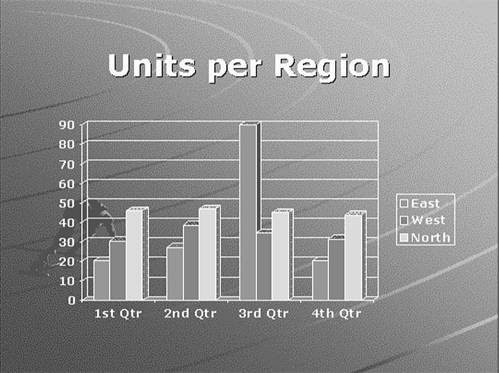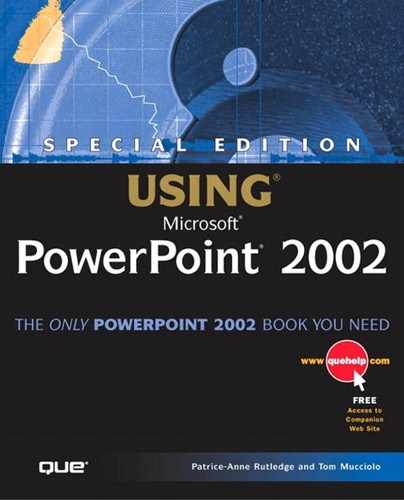Understanding PowerPoint Presentations
Once you learn—or refresh your memory of—how to navigate PowerPoint, you can create a basic presentation. This chapter gets you up and running on presentation basics so that you can quickly move forward to more advanced and sophisticated PowerPoint techniques.
In PowerPoint, you can create a presentation in several different ways, depending on the amount of content and design assistance you require. You can create
A presentation using the AutoContent Wizard The wizard selects a design template that matches your presentation type and creates a series of slides with content and slide layout suggestions. Using the AutoContent Wizard can help you save time and provide detailed design assistance if you aren't yet design savvy.
A presentation using a design template This lets you add your own slides and content and still have a consistent design scheme (layout, colors, fonts, and so on). You also can create a presentation using your own template on a Web server or computer. Downloading a template from Microsoft's Web site is another option.
A new presentation from an existing presentation This option enables you to create a new presentation that you can edit and modify by copying an existing one. The existing presentation remains as is.
A blank presentation This type of presentation includes no preset design, colors, or content suggestions. Create a blank presentation only when you are very experienced with PowerPoint and know you want to create a custom design rather than use one of PowerPoint's existing designs.
Tip from
Even if you want to create a custom presentation, it often saves you time to start with a similar existing design and then customize it.
Understanding Design Templates
A design template includes preformatted fonts, colors, and styles that blend together to create a consistent look and feel for your presentation. You apply design templates using the Slide Design task pane. It's usually a good idea to apply a single design template to a presentation for consistency, but you can apply multiple design templates to a single presentation if you want. Figure 2.1 illustrates a sample design template.
The AutoContent Wizard automatically selects a design template that is suited to the type of presentation you want to make. If you don't use the AutoContent Wizard and instead select your own design template, be sure that the template you select matches your audience and fits the message you want to convey.
Figure 2.1. An artsy design is great for an artistic crowd but not something you would use for a corporate audience.

 Depending on which method you use to create a new presentation, your presentation may already contain a design template. If you want to view the templates ahead of time, apply one directly to a presentation, or change to a different template, you can do so directly by clicking the Design button on the Formatting toolbar to open the Slide Design task pane.
Depending on which method you use to create a new presentation, your presentation may already contain a design template. If you want to view the templates ahead of time, apply one directly to a presentation, or change to a different template, you can do so directly by clicking the Design button on the Formatting toolbar to open the Slide Design task pane.
Understanding Slide Layouts
In addition to a design template, the other important design feature you need to consider is a slide layout. A slide layout helps you add specific types of content to your slides, such as text, tables, charts, and pictures.
Even though PowerPoint provides a multitude of layout combinations from which to choose, these layouts contain a total of only seven different elements. They are
Text Inserts a placeholder on a slide in which you can add the desired text, such as a title or bulleted list.
→ To explore the ways you can add desired text, such as a title or bulleted list, see Chapter 3, “Working with Text.”
→ To explore the ways you can work with tables even more, see Chapter 4, “Working with Tables.”
Charts Inserts a chart such as a bar, column, or pie chart in your presentation. Charts offer a visual means for showing relative sizes. Charts are excellent when showing cost allocation or percentages of sales figures. Figure 2.2 illustrates a chart.
Figure 2.2. Charts can add visual punch to a presentation.

→ For more information about using charts in PowerPoint, see Chapter 11, “Working with Charts.”
Diagrams or Organization Charts Opens the Diagram Gallery, from which you can create a variety of diagrams and organization charts. Figure 2.3 illustrates such a chart.
Figure 2.3. Use an organization chart to help present your organization to new team members.

Note
PowerPoint 2002 includes totally revised organization chart capabilities directly in PowerPoint, rather than relying on an external charting program. This new feature also includes the capability to create diagrams such as cycle, radial, pyramid, venn, and target diagrams.
→ To learn more about diagrams and org charts, see Chapter 12, “Working with Diagrams and Organization Charts.”
Clip Art Inserts a clip art image in your presentation, either from Office's vast collection of ready-made graphic images or from your own computer or network. Figure 2.4 illustrates a slide that contains clip art.
Figure 2.4. Clip art provides numerous ways to illustrate the basic concepts of your presentation.

→ To learn more about working with clip art in PowerPoint, see Chapter 13, “Working with Media Clips and the Clip Organizer.”
Media Clips Inserts a media clip, such as a sound or movie file, enabling you to add musical effects to your presentation or display a video within it.
→ To learn more about inserting media clips, see Chapter 13.
Pictures Opens the Insert Picture dialog box, from which you can insert graphic files such as GIFs or JPEGs. A picture is very similar to clip art, except that you use the Insert Picture dialog box to find your own graphic images rather than insert one from the gallery.
→ To learn more about inserting pictures, see Chapter 14, “Creating and Formatting Objects.”
You add each of these elements to a PowerPoint slide using the Slide Layout task pane. On this task pane, PowerPoint offers 27 different types of slide layouts divided into four categories:
Text Layout A text layout contains only text. The slide may contain a title, one- or two-column text, or a combination of the two.
Content Layout Content layout slides offer the option of one, two, three, or four pieces of content in several arrangements. Content is defined as a graph, photo, organization chart, or other visual element.
Text and Content Layout The seven text and content layouts offer various options of placing both text and pieces of content on a slide.
Other Layout This section includes layouts that don't fit the other categories. Options include the capability to create a slide with a single table, diagram, or organization chart or to create combinations with text, media clips, clip art, and charts.
Note
If none of these predefined layouts is what you want, you can modify a blank slide or customize one of the existing layouts by adding, moving, or deleting objects.
Depending on which method you use to create a new presentation, it might already contain slide layouts. If you want to view these layouts before you create a presentation, apply them directly to a slide, or change a layout, you can do so directly by choosing Format, Slide Layout to open the Slide Layout task pane.
Many of PowerPoint's slide layouts include an option for inserting content. For example, if you choose any of the layouts under Content Layout or Text and Content Layout in the Slide Layout task pane, a content palette will appear as a placeholder. This content palette includes six buttons:
| Insert Table | |
| Insert Chart | |
| Insert Clip Art | |
| Insert Picture | |
| Insert Diagram or Organization Chart | |
| Media Clip |
You'll note that, with the exception of pictures, PowerPoint also includes separate layouts specifically for adding the other content types. For example, you can also insert a table using the Title and Table slide layout or a chart using the Title and Chart; Title, Text, and Chart; or Title, Chart, and Text slide layout. What's the difference? Mainly, it's a choice of location on the slide, formatting, and content combinations. You should experiment with the available slide layouts in PowerPoint 2002 to determine exactly which work best for your presentation.
